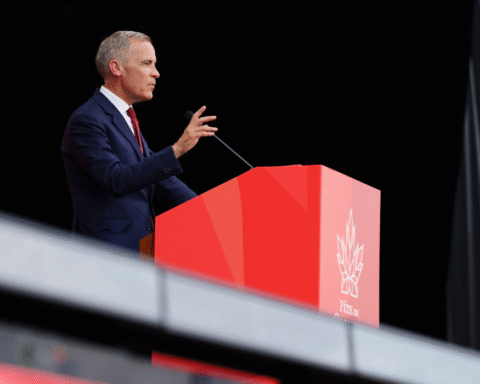In the first week of Canada’s 2025 federal election campaign, both the Liberal and Conservative parties unveiled personal income tax cuts sold as providing relief to Canadians staring down the threat of both tariffs and economic annexation emanating from the White House.
While putting a tax cut in the window is standard fare for Canadian political campaigns, the focus ignores a largely invisible tax on everyday Canadians and a growing threat to the future of Canada as an independent nation: monopolies.
Before the election of Donald Trump in the United States, Canada was set to have an affordability election, driven primarily by the cost of housing and the prices shoppers saw on grocery store shelves. Grocery prices became a political flashpoint, with supermarket CEOs appearing before Parliament to justify their ballooning profits in the face of rising food insecurity and exploding food bank usage. Now in the rearview, the centres of electoral gravity for voters were split along generational lines between affordability and threats emanating from the Trump administration.
As part of its suite of policy responses to the cost-of-living crisis, in 2023 and 2024 the federal government strengthened Canada’s Competition Act, a relatively esoteric yet powerful piece of economic policy. The law polices the behaviour of large corporations and shapes the flow of mergers and acquisitions that can reduce choice and competition for consumers and businesses. Stronger laws meant Canada’s competition cop, the Competition Bureau, had more tools to go after the companies that had set themselves up as gatekeepers on the choke points of our economy.
There are many dimensions to the costs imposed by monopolies or oligopolies, shorthand terms for situations where one business or a group of businesses hold too much power relative to customers, workers or suppliers. The most common is price, which makes up the most visible component of the monopoly tax. Anyone buying a beer at a baseball game is familiar with the experience. With limited competing options, customers face high prices and can choose to stomach the inflated cost or do without. Those price premiums that would otherwise be competed away if the market was working correctly can be thought of as a monopoly tax on our economy.
Though a single economy-wide measure is not available, quick math in key sectors shows the potential return Canadians could stand to gain if we took monopoly seriously in our country.
The amount the average Canadian hands a telecom each month was almost $70 in 2023. In Australia, the largest carrier brought in approximately $44 per user.
If Canada’s telecoms dropped their rates by just 20%, that would transfer $6 billion annually back to Canadians.
In their study of the retail grocery space, Canada’s Competition Bureau found that grocers’ profit margins had risen by a “modest but meaningful amount” in the years following the pandemic. Make no mistake: grocery store margins are relatively thin, in the vicinity of 7% to 10% and typically lower on foodstuffs. But a monopolist can flex a low-margin business across high volumes to reap serious rewards. Contrast these findings with those of the United Kingdom’s competition law-enforcement agency, the Competition and Markets Authority. Since the onset of the pandemic, all but the largest U.K. grocery chains saw compression of their profit margins, suggesting that the burden of inflationary pressures was shared between retailers and shoppers rather than the Canadian model, which fully shifted it to consumers.
While Canadian grocers have refused to reveal the margins they earn on food products, instead presenting blended margins across their entire business, major grocers saw profits rise in the years following the pandemic. Since 2020, Loblaw’s net earnings have risen more than a billion dollars, nearly doubling from $1.2 to $2.2 billion. But those profits paper over the dollars grocery giants used to buy back their own shares from existing shareholders. They do this to engineer healthy stock prices, rather than invest in their operations or lower costs to woo customers. From 2022 to 2024, Loblaw alone bought back nearly $5 billion of its own stock, with Metro and Empire trailing at $1.5 billion and $1 billion, respectively. In contrast, the more competitive market in the United Kingdom has giant grocers currently engaged in a price war that benefits shoppers.
A familiar pattern
What about another familiar monopoly pain point in Canada: the cost to access wireless services? In 2023, Canadians spent just over $30 billion keeping ourselves collectively glued to our phones. Breaking that down to the individual level, the Canadian Radio-television and Telecommunication Commission (CRTC) estimated that the average revenue per user (ARPU), how much money the average Canadian hands to a telecom each month, was almost $70. Looking at Australia, a market with similar geography and population density as Canada, the largest carrier reported wireless ARPU of approximately $44, with other carriers reporting even leaner figures. Even if Canada’s telecoms raked in ARPU that was just 20% lower than the current level, that would mean a transfer of $6 billion annually back into the pockets of Canadians.
Banking is another sector where a few familiar faces loom large. Though banking has more independent players than telecommunications – five players hold about 90% market share as opposed to three – outcomes are familiar to those on the lookout for monopoly. While the level of concentration in Canada’s banking sector is not unique, Canadian banks are some of the most profitable on the planet. That means that every dollar of deposits they take in or dollar of lending they send out generates a higher return compared to international counterparts. This is especially the case for the everyday banking services Canadians use, where the banks’ “stranglehold” reaps profit margins in the neighbourhood of 30%.
Banks make those margins from two major revenue sources: the difference between interest charged on loans and paid out on deposits, and the fees charged for access to banking services. Looking at just the fees side of the equation, economist Alain de Bossart puts the cost of Canada’s banking oligopoly at an extra $8.5 billion per year – or $250 per adult – when compared to countries like the United Kingdom with more competitive banking sectors. Bucking the idea that there is a tension between the level of competition and stability of the financial sector, the U.K. banking sector and its regulators have been able to deliver protection for the life savings of Brits while providing the lower prices and better services that competition brings.
This pattern is repeated in markets across the Canadian economy. Many of the intermediary industries that consumers rarely interact with directly have seen shocking levels of consolidation in the past decades. For example, nearly all beef processing that occurs in the country is handled by two foreign companies, JBS and Cargill, which have split the markets of the country regionally. This dominance gives the firms pricing power over ranchers, who face a take-it-or-leave-it choice to get their products to market.
Tallying up all of the above estimates on a handful of sectors suggests that the monopoly tax for Canadians runs up to tens of billions annually, dwarfing the income tax cuts proposed by either the Liberals or Conservatives in their election platforms.
From tax to sovereignty
While the dollar costs of monopolies may be the most in-your-face component of their cost, the early months of the second Trump administration have been a reminder that the cost of monopolies runs much deeper. One that we ignore at our own risk.
Moving beyond just price, monopolies are really about control: who has it and who does not – in markets, in the economy and in our lives. When we are subject to a monopoly, our freedom is curtailed by the interests of that monopoly. This concept scales easily from the very micro to the macro. You lack control when your building has a single internet provider, when an employer slaps a non-compete clause on your employment contract, when a company limits the stream of information fed to you and your community, and when a single country is responsible for much of the global production of an important product, or inversely, the lion’s share of your exports.
In response, we attempt to offset these lacks in our economy and society through a variety of methods. We set the rules of the road for markets and allow individuals and companies to compete, and we create institutions and checks and balances to ensure that no individual institution becomes too powerful. The results are imperfect and evolving, but they stem from an understanding that being on the wrong side of a monopoly is hazardous to us and our society.
This is part of the reason why it’s important to understand that the economic volatility and national soul-searching of late in Canada that appears to be a Trump problem is, ultimately, a monopoly problem. In ways we are now being reminded of daily, we have integrated our economy with a country with a much greater gravitational pull than our own and are now faced with the consequences as it charts a very different course for itself and the rest of the world.
The danger that slims the pockets of Canadians is the same one that puts the future of our sovereignty at risk. We need to take a broader view of the risks present from our not-so-friendly neighbour to the south so that we can begin the process of mitigating them.
The cost of Canada’s banking oligopoly is pegged at an extra $8.5 billion per year, or $250 per adult, compared to countries like the United Kingdom.
No picture summed up one of the key monopoly risks of the current state of play more than the front rows at Trump’s inauguration. After feting the president with millions in donations, the billionaire CEOs of the world’s largest technology companies were front and centre as the new president was sworn in. These people represent not only vast wealth but control over the main methods that Canadians use to access information, communicate with one another and build their businesses. As Canada enters a new era of its relationship with the United States, we should realize the ability of these firms to shape the information environment around us and expect access to critical services like cloud computing to become tokens to be exchanged for deeper incursions into our sovereignty. The Trump administration has made clear that it considers attempts by other countries to police the operations of tech platforms within their jurisdiction as affronts to U.S. innovators. The assumption that these threats will extend only to seemingly esoteric policies like competition and online safety is likely to prove short-lived.
Thankfully, Canada is not alone in re-evaluating the risks posed by its integration with U.S. technology companies. While the United Kingdom has taken the tack of placating Big Tech to gain favour with the Trump administration, the EU has signalled that it is ready to stand firm on its efforts to maintain its sovereignty over firms operating in its jurisdiction with legislation like the Digital Markets Act.
Standing up to monopolies at home will mean embracing competition, empowering other firms that are seeking to disrupt the status quo and strengthening the Competition Bureau so that those firms can compete freely and fairly. Standing up to the monopolies that span far beyond our borders will mean a deeper level of partnership and coordination with allies that understand that the sovereignty of nations is a value worth fighting for.
The task of Canada’s new federal government is not enviable. The monopoly threats from abroad to Canada’s independence have never been greater, and we must forge a path divergent from the pro-consolidation and U.S.-centric consensus that drove the past 40 years of policy-making. But while a Team Canada approach is appealing amid a surge in nationalistic sentiment, we cannot lose sight of the monopoly tax that has been levied on Canadians year after year by companies operating within and across our borders.
In both cases, the task for Canadians is to prove that we are masters in our own house, in control of our economic destiny.
Keldon Bester is the executive director of the Canadian Anti-Monopoly Project, a fellow at the Centre for International Governance Innovation, and a former special adviser at the Competition Bureau.
The Weekly Roundup
Get all our stories in one place, every Wednesday at noon EST.






